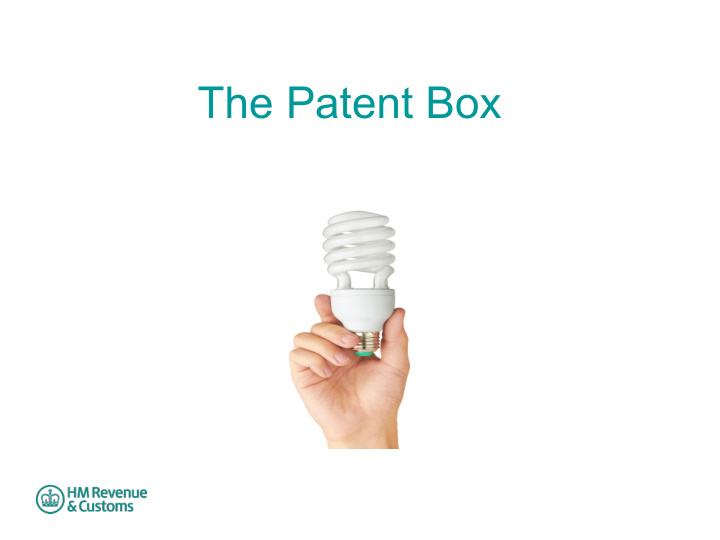



The Patent Box
Context The Patent Box is a key initiative in making the UK tax regime competitive for innovative high-tech companies, driving growth and investment in the UK, creating high-value jobs in innovative industries, and building on the UK’s long and proud history of great inventions and discoveries. - David Gauke, when Financial Secretary to the Treasury
Patent Box & R&D relief • R&D relief – Compensates businesses for speculative expenditure – To an extent via RDEC reduces blue sky R&D risk • Patent Box – Applies to successful R&D – Increases the potential rewards • Together provide a framework to encourage innovative R&D and its commercialisation in the UK.
What is Patent Box? • Reduced rate of Corporation Tax • On income from patents and similar IP • 10% rate, when fully phased in, from 2017
Aims • Provides incentive for UK companies to undertake R&D and retain and commercialise IP resulting from that R&D in the UK • Updated in FA2016 to comply with new OECD rules, linking relief to substantive R&D activity • Government remains committed to Patent Box as part of competitive CT system
New OECD compliant rules • For all new patent box elections applying after 1 July 2016 • And new IP for companies already elected in, subject to transitional rules for new IP incorporating into an existing product. • Tracking & tracing - companies must identify the percentage of development (“R&D fraction”) carried out on the IP within that company. If the fraction is less than 1 it will reduce the amount of profit from the IP that can go in the Patent Box. HMRC NL Standard | 17/03/2016| 6
Time limits to elect in • Companies need to elect in to Patent Box. • A company can elect in to the regime within 2 years of end of Accounting Period • New Patent Box rules only apply to new entrants, and new IP – till 2012. • No need to make an election by 30/6/16
Qualifying for the Patent Box • Company must hold qualifying IP • Company (or a member of its group) must have significant involvement in developing it. • Company itself must at least actively manage the exploitation of the IP. • IP in point is mainly in date patents granted by approved patent authorities, including those listed at CIRD210150 • Certain other rights also qualify.
Qualifying Income • Worldwide royalties from licensing • Worldwide sales of items incorporating qualifying patented item • Sales of the qualifying patent rights • Infringement income or other compensation • Using a patented process to produce non patented items or patented items to provide a service
Benefit • Though it amounts to a 10% rate of CT, Patent Box is actually provided by giving the company an additional deduction. • The deduction is calculated to give the same value as the reduced rate. • It is calculated through a formula, based on a company’s patent profit. • Computation has three stages
Computation – part 1 • First, identify relevant income as a proportion of total income. • Then, either apply the same percentage or streamed deductions to obtain relevant profit or allocate income & expenditure to qualifying & non qualifying streams (“streaming”) and calculate difference. • The new regime will only have streaming.
Profit consists of various elements • Marketing product and making it fashionable/ Marketing IP Profit desirable increases profit. • Technological advances protected by IP such as R&D IP Profit patent IP increase profit. • Routine profit earned Routine Profit where no IP held.
Computation – part 2 • Only profit related to the IP exploitation falls into the Patent Box • Therefore need to remove the profits relating to routine return (at a rate of 10% of listed expenses). • Then remove profit relating to marketing and branding
Computation – part 3 • Finally, the calculation reduces the profit – for each stream – by multiplying it by the R&D fraction for that stream. • I tried to get the Parliamentary draftspeople to put this in the legislation as a vector scalar product – two lists of numbers in which equivalent terms are multiplied – but oddly they wouldn’t do that • The remaining profit is called relevant profit and the rate of tax applied to this is 10% • In order to fit into the main tax computation this is done by calculating an extra tax deduction using a formula.
R&D Fraction • Defined for the stream as !"#$ ×$.( !"#$")"#* • Where – D is in-house direct R&D expenditure on IP in the stream – S1 is third party subcontracted R&D expenditure – A is expenditure on acquisition of IP – S2 is related party subcontracted R&D expenditure – 1.3 is a 30% uplift allowed (cannot increase fraction beyond 1) • Fraction will change each year as expenditure changes – new expenditure added and, eventually, older expenditure removed
Record keeping • Need to decide at what level to track and trace – IP asset (ideal) – Product – Product family • Explanation of the choice of streaming level • R&D expenditure • Acquisition expenditure HMRC NL Standard | 05/08/2013 | 16
Unfinished business • Cost sharing arrangements • Not included in FA2016 legislation – complex and difficult to get right • Minister announced during progress of legislation in the Summer that we would address this in next Finance Bill • Expect to publish draft legislation in the Autumn
Questions? ? ? David Harris ? 03000 586834 / 07469 023339 ? david.harris@hmrc.gsi.gov.uk https://www.gov.uk/guidance/corporation-tax-the-patent-box
Recommend
More recommend